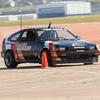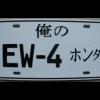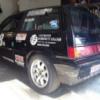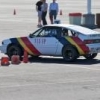I have been wondering this for a while and have never had an adequate response. With all other things being equal (except a properly valved shock) and a class that allows you to change tire pressure, spring rate, and/or sway bar which is it better to stiffen a rear end by. I am looking at adjusting the rear of a front wheel drive car for looseness/rotation. Keep in mind it is a relatively smooth racing surface.
What I have heard is that every lb. of air pressure is approximately 10 lbs. of spring rate. Therefore, if I need to spring an 800 lb. corner of a car, with the desired balance/rotation, I could use say 30 lbs. of air pressure in the tire (30x10 lb. = 300 lbs.), a 300 lb. spring (rate), and a 1 inch thick sway bar to pull 200 lbs. of spring rate from the other side of the car. Let’s say once we load and match the 800 lb. corner weight at that point the car starts to rotate. With this premise, I could run 25 lbs. of air pressure (25x10 lb. = 250 lbs.), a 550 lb. spring, and no sway bar to get the same effect. Or even 50 lbs. of air pressure in the tire (50x10 lb. = 500 lbs.), a 200 lb. spring, and a 1/2 inch thick sway bar to pull 100 lbs. of spring rate from the other side of the car.
Please keep in mind increasing tire pressure crowns a tire, increasing spring makes a tire skip over the road, and increasing sway bar makes your suspension less independent and/or more connected.
With all that said I have two main questions…
What should you increase or decrease and why (tire pressure, spring, or sway bar)?
On a short wheel base, solid rear axle, Honda CRX I am trying to reduce snap oversteer. I am thinking to reduce tire pressure to maximize tire contact patch and compliance to ground. Then increase spring rate and get as much bind as possible out of the rear end suspension to maximize the articulation of the rear end with its pan hard bar geometry.
Thoughts?
 Sign In
Sign In Create Account
Create Account




 Back to top
Back to top


 View Garage
View Garage










